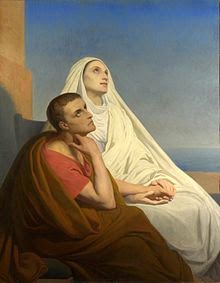“You are great, Lord, and highly to be praised: great is your power and your wisdom is immeasurable.”
Oxford World Classics
Translation: Henry Chadwick
I’m starting my Well-Educated Mind Biography Project with possibly the first biography ever written, Confessions by St. Augustine. Born in 354 A.D. in Thagaste, which is modern day Algeria, Augustine reveals his time as a boy growing up in North Africa, his profession as a teacher of rhetoric, his travels to Rome, his connections with the Manicheans*, and finally his conversion to Christianity. We, as a reader, are privileged to have a window into his life and internal struggles, as he asks questions about life and God.
*Manicheanism: a quasi-religion that taught a dualism of everything that is material is evil, and everything that is spirit is good. Their beliefs caused them to take rather bizarre views of Christian teachings such as: because God created a material world, he cannot be good; Jesus did not become man because all material is evil, etc.
First Stage of Reading:
Augustine was born in a century where at the beginning, Christianity was a persecuted religion, yet at the end of the century most people of the Roman Empire were at least ostensibly Christian and Christianity was the official religion of the Empire. As the church attempted to determine its nature, there were many disputes among Christians and much of Augustine’s writing deals with these issues. He also endeavoured to reconcile pagan thought with Christian values, one of the first Latin writers to explore the benefits of pagan ideas as well as assessing their limitations.
Perhaps the most important person in Augustine’s life was his mother, Monica. Her prayers and petitions for him were unceasing and what a wonderful thing for her to see him eventually become a believer.
Ambrose, the archbishop of Milan, was instrumental in Augustine’s journey away from Manichean belief and towards a belief in God. Augustine respected his intellect and his influence on Augustine was unequivocal, as he encouraged him to look beyond the literal into the substance of the Bible, and asserted that a deeper meaning could be found there, contrary to what Augustine had learned from his Manichean teachers.
The Second Stage of Reading:
 |
| The Confessions of Saint Augustine source Wikipedia |
The Third Stage of Reading:
 |
| Saint Augustine & Saint Monica (1846) Ary Scheffer source Wikipedia |
This book is broken up into two section, the first being Augustine’s autobiography (the first 9 books) and the second being theological & philosophical works (the last 4 books). With regard to the latter, Augustine’s curiosity and quite astounding intellect can leave his reader going “huh?” as we try to navigate with him through the quite confusing realms of memory & senses, the meaning of time, and the book of Genesis and how it intersects with the Trinity. In retrospect, the change in tone between these two sections are perhaps not as unusual as they first appear. In the first nine autobiographical books, Augustine is dealing with the past, yet with the second section, he deals with the present and some of the thoughts that he is reflecting on during his life as a bishop. These subjects also tie into the material he has already presented: memory affects his presentation of his past experiences, time relates to the existence of his past recollections, and the chapters on Genesis and the Trinity are reminiscent of his earlier inquiries on how to read the Bible and how to view God.
During my first reading of Confessions, the last few chapters honestly went over my head, but with this second reading, I was able to follow Augustine’s train of thought at least now and then. I will definitely re-read this book in the future. There is so much to draw from this great intellect and I still feel that I have only scratched the surface.
 |
| Portrait by Phillipe de Champaigne 17th century source Wikipedia |
Favourite Quotes:



